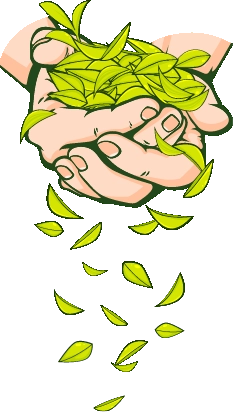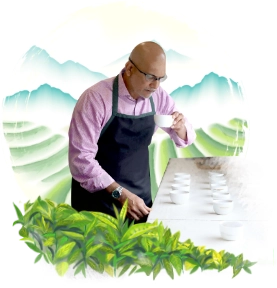Castleton Tea Estate
- Established in : 1985.
- Location : Kurseong’s south valley, an hour’s drive from Darjeeling town
- Elevation : 980-2300 metres above sea level
- Famous for producing the finest muscatel Darjeeling teas.
- First Muscatel Tea was made here.
- Set a world record with a Muscatel batch being sold for Rs.13001/kg at the Calcutta Auction.
If Darjeeling tea is the Champagne of teas, then definitely the elusive Muscatel tea is the Champagne of Darjeeling teas. And the renowned Castleton tea estate produces some of the finest Muscatel teas in the world! In fact, the first ever Muscatel tea was made here in 1985.
Located in the South Kurseong subdivision of the Darjeeling district, the garden was planted and started by Dr. Charles Graham in the year 1885. Following a few changes in ownership / management, the garden was purchased in 1945 by the Roy family of Calcutta who renamed the garden ‘Gourishankar’ – after their daughter (Gouri) and son (Shankar). The Coventry Tea and Engineering Co. (P) Limited took over ownership of the garden in 1965 and held the property till the present owners, Amgoorie India Ltd., a subsidiary of the Goodricke Group Ltd., part Camellia Plc. bought over the garden in 1984.
The 130-years old garden has an altitude ranging from 980 metres to 2300 metres, characterized of lush hilly slopes of Kurseong and Pankhabari. With a plantation area of 170 hectares, Castleton has an almost cult-like status amongst tea connoisseurs and has an annual production of 30,545 kilograms.
Also locally known as ‘Kumseri’, this picturesque tea garden had a building called “Bank Ghar” in its vicinity which had the features of a traditional castle, hence giving the garden the name ‘Castleton’.
One of the unique facts from this garden is that they have names for their individual tea sections, instead of the usual rule of assigning a number for these sections. The names are : “Bhalu Khop” which in the local language means a bear cave ; there’s “Dhobitar” which means washerman’s clothes-line ; “Baseri” which stands for a place to rest ; and “Jim Basha” which means an erstwhile manager’s place.
Another interesting fact about Castleton – in 1992, a batch of Castleton Muscatel tea was sold at a whopping price of Rs. 13,001 per kg at the Calcutta tea auction. Castleton is the first tea garden to received ISO 9002 certification. It is also FSSC 22000 Certified, Rainforest Alliance Certified and ETP Certified.
Springside, a division and part of Castleton Tea estate, was also planted by Dr. Charles Graham in 1865 with Castleton and was named so because the factory was situated beside a spring near the forest-covered ridge of Kurseong. The local name is ‘Watting Kaman’ named after a certain Mr. Watting, and is still in use till date.
The ownership changed hands numerous times with Dr. Graham, Mr. Cochrane, and
Mr. Mill left indelible marks on the property. Following the departure of the British, the garden passed through several hands before being acquired by Amgoorie India Ltd. in 1985.
- Castleton Tea Garden has two divisions – Springside and Castleton
- Castleton is also locally called Gouri Shankar and Kumseri
- The Castleton division and a part of Springside have got sectional names instead of numbers, as is the usual practice. These are ‘Bhalu khop’ (Bear’s Cave); ‘Baseri’ (Resting Place); ‘Paila kheti’ (First Field); ‘Jim Basha’ (Jim’s Children – the section was planted by one Mr Jim); ‘Siroobari’ (Thatch field); Orange Grove; ‘Ayna Kothi’ (Glass Bungalow); and ‘Panchpatay’ (Five Leaves).
Castleton has almost a cult-like status amongst tea connoisseurs. In 1992, a batch of Castleton Muscatel tea was sold at a whopping price of Rs. 13,001 per kg at the Calcutta tea auction. The First Muscatel Tea was also harvested at Castleton.
If Darjeeling tea is the Champagne of teas, then definitely the elusive Muscatel tea is the Champagne of Darjeeling teas. And Castleton tea estate produces some of the finest Muscatel teas in the world! In fact, the first ever Muscatel tea was made here in 1985.
The First Muscatel Tea
The first Muscatel tea was produced at the world-famous Castleton Tea Estate in 1985. The credit goes to the then factory manager of the estate, Mr. A.K. Gomden. He noticed in June of 1985 that the teas produced had a very peculiar and intense flavour, which was quite unlike and different from the normal flavoury teas produced during the time. He was at a loss on what marking should be used to describe this truly intense and incredible tea. He then requested the Late Vijay Dudeja, an authority on Darjeeling tea during those days, to visit Castleton and taste the tea.
When Mr. Dudeja tasted the tea, he found that they had a distinct fruity flavour, rich and intense that lingered on the palate. Being a much-travelled man, he immediately knew this was a special tea, and was very similar to the rich, intense Muscat grapes, used for making fine wines. Spontaneously and on the spot, he named this batch of teas, Muscatel – like Muscat grapes. Since then, Castleton Muscatel teas have won top awards and honours internationally, not to mention world-record prices. The award winning lot Castleton tea that was sold for Rs. 13,0001 per kg. at the Calcutta tea auction in 1992 was indeed, a Castleton Muscatel FTGFOP1!
Today, select estates that make fine Muscatel teas include Jungpana, Giddapahar, Gopaldhara, Seeyok and Okayti. From the top tea boutiques in the world to the most exclusive and prestigious tea-rooms in the UK and Europe, Muscatel teas are amongst the most prized and sought after by connoisseurs. And the moments of sipping and savouring this exquisite Muscatel tea becomes life’s sweetest memories – like the shortest love.

Tea is a religion in the art of life.

